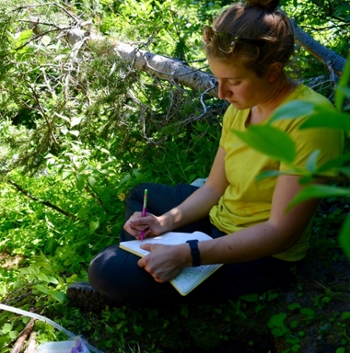EAPS Graduate Student Studying Glacial Meltwater Using DNA Tracers
02-19-2018
Writer(s): Logan Judy

From spending most of her life in one state to traveling the country to study hydrogeology, Jordyn Miller experienced quite the transition when she came to EAPS.
“The majority of traveling my family did was driving two hours to the beach,” she said, “so I never saw the western part of the United States before coming here.”
Miller was born and raised in the state of Pennsylvania, where she attended Wilkes University and received a Bachelor of Science degree in Mechanical Engineering. Shortly after, she began working for an aerospace company designing jet engine components. However, she soon had an itch to pursue something that would take her out of the office.
“I felt trapped in my cubicle all day at my engineering job, and I love the outdoors, so I was sitting at my desk one day wondering, ‘How can I combine these two disciplines?’”
Now, as a PhD student in EAPS, she has. Her research destinations have included Mt. Hood National Forest, Oregon and Glacier National Park, Montana, as well as being a field assistant for other research in Death Valley, California and the Pacific Northwest. Her advisor, Dr. Marty Frisbee, has a similar background – he also obtained an engineering degree before fostering a passion for geology, and hydrogeology in particular. Now in her third year, Miller studies the dynamics between melting alpine glaciers and its impacts on groundwater, which can have significant implications for communities in those areas.
“People use water that comes from glacial melt,” she said. “For example, communities living close to Himalayan glaciers depend on surface meltwater for basic needs. As the glaciers retreat and eventually disappear, the water resources will also change. I suspect the same will happen around Mt. Hood and in Glacier National Park.”
Part of that research entails tracking where the glacial meltwater goes. That presents logistical challenges – challenges that Miller hopes to solve with an unconventional and multidisciplinary approach, one which resulted in her receiving a fellowship. Working with Dr. Trinity Hamilton of the University of Minnesota, she hopes to identify biological signatures in glacial ice in order to track groundwater flow.
“We’re using DNA as a tracer,” she said. “The DNA from organisms and microbes that live in glacial ice theoretically will be traveling within the water and through the ground. Then, assuming this is happening, they should be present in the spring water exiting elsewhere on the mountain and surrounding region. This offers a unique connection between the glacier and mountain groundwater”
Because of this innovative research proposal, she was awarded the CUAHSI Pathfinder Fellowship, which provides travel funds to students in hydrology and other related fields of study to collaborate with researchers outside of their field to enhance their research. The fellowship covers travel costs up to $5,000 and is provided by the Consortium of Universities for the Advancement of Hydrologic Science, Inc., a National Science Foundation-sponsored organization. Miller plans to take multiple trips to work with Dr. Hamilton at the University of Minnesota, as well as complete another field campaign to Mt. Hood and Glacier National Park this summer.